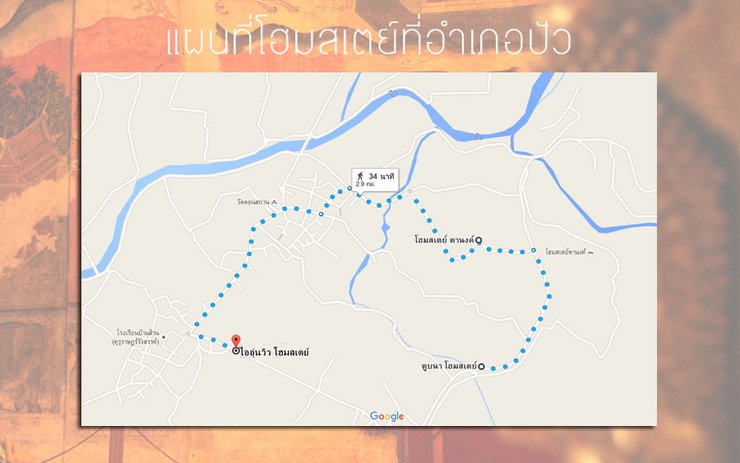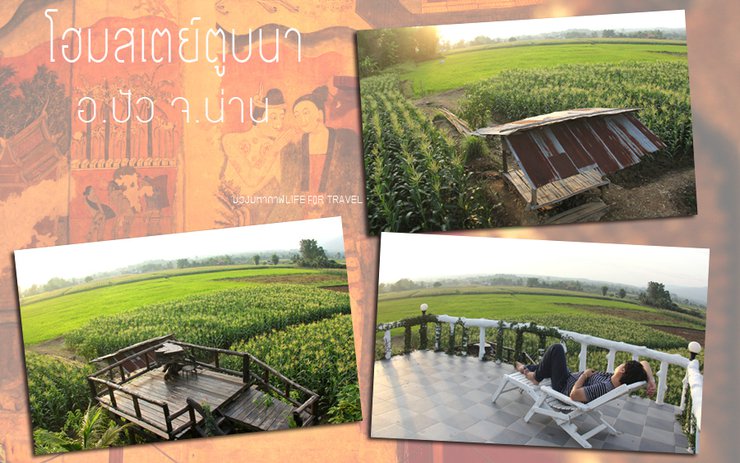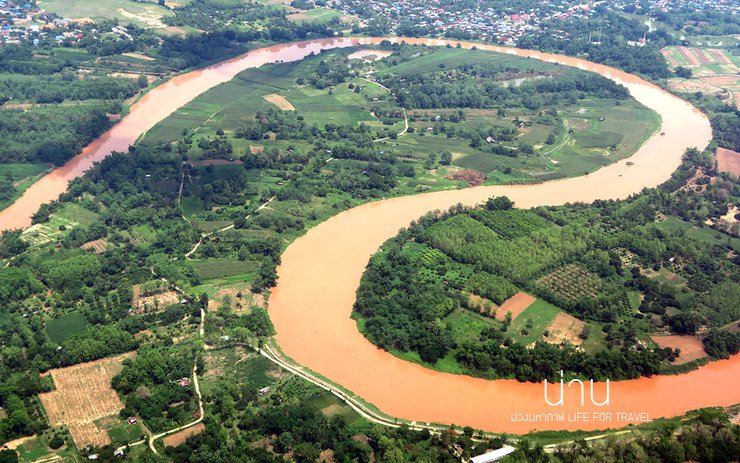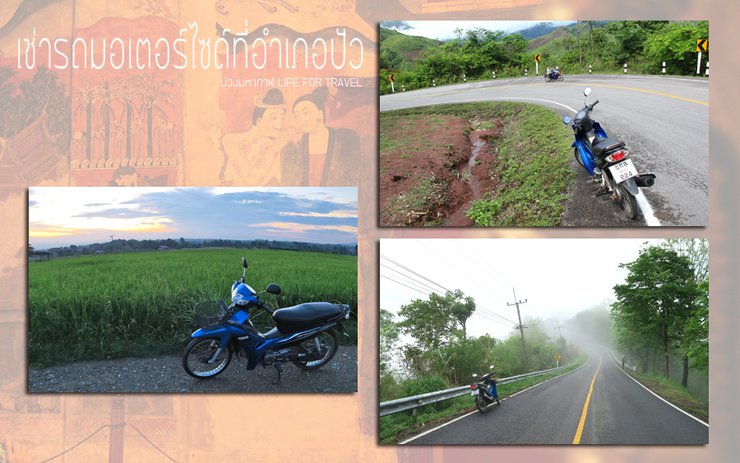This travelogue will explore the tourist attractions of Nan and Phrae provinces as the spring season approaches. The magic of the rainy season will bring back the lush greenery, and the tourist season is about to begin...

Another travel destination in my style, Purple Mahakal, LIFE FOR TRAVEL https://www.facebook.com/PEESAT.PANTIP/
The skies above Nan are now starting to turn lush and green.
The red water, like a signal, indicates that the rain is starting to work.
Along with the happiness that is about to begin for visitors from afar

This trip may be different from all the others.
More than just a tourist destination, I wanted to experience the atmosphere of something different.
I took a red bus to reach Pua district, boarding at the airport.
A distance of about 60 kilometers, costing 50 baht, but taking almost 2 hours to travel.
It may seem slow, but it feels exciting and fun in a way that can't be described.

Pua, a small district surrounded by mountains
The first touch, you can feel the moisture and greenery of the mountains.

I'm looking to rent a motorbike from downtown Pua for 300 baht per day.
To drive around the district, where the tourist attractions are not far from each other.
Including driving to Bo Kluea District, which is about 50 kilometers away.

Map of accommodation in Pua, which is mostly homestay style next to rice fields.
There are many places to stay, but here are 3 of the most outstanding options for your consideration.

"Tanong Homestay" is one of the most famous homestays in Pua District.
With its simple and comfortable atmosphere, surrounded by rice fields and mountains.
Many people therefore want to stay here when visiting Pua District.

"Homestay Ai-Uan View," a small but cozy accommodation that lives up to its name.
At a very affordable price of only 400 baht per night, this is definitely another option that is worth considering.

"Homestay Tub Na" is a new and promising homestay that looks more beautiful than any other.
However, the price is quite high compared to other places.

A beautiful view of the Tub Na Homestay, overlooking the vast rice fields.
The simplicity and tranquility that surrounds us amidst the mountains

Although it is just entering the rainy season, the rice fields in Pua District are already lush and green.
Most of the land is used for growing glutinous rice, which can be harvested multiple times a year.

Another charm that I would like you to experience is the way of life.
Available at the village market, where trading takes place in the evening.
The products will be in a rustic style, some of which I've never even heard of before.

From the city center, I started riding a motorcycle according to the map.

The first place is "Phuket Temple". Hearing the name, you might think it's in the south.
But here is Nan province, the highlight of Wat Phukhao is the scenic view from the temple.
The most beautiful scenery of mountains and lush rice fields can be seen around September.

Not far from Phuket Temple, on the main road, is the "Baan Tai Lue Coffee Shop".
Its outstanding and fascinating identity lies in the beautiful preservation of the ancient Tai Lue culture.

The picturesque surroundings of the "Baan Tai Lue Coffee Shop", adorned with rolling hills and majestic mountains,
Especially during the rice-growing season, the scenery is even more beautiful, surrounded by lush greenery around the coffee shop.

Located near the coffee shop is the "Lam Duan Woven Fabric" store.
With meticulousness and preservation of traditional production methods.
In addition to the very affordable prices, there is a constant stream of tourists coming to shop for goods.

Not far from here is another tourist attraction that you should not miss when visiting Pua.
"Mushroom farm at Baan Hua Nam" is a peaceful and shady corner surrounded by lush greenery.

This farm will have a restaurant with a healthy menu made from a variety of mushrooms grown on site.
There are also beautiful accommodations that are perfectly nestled in nature.

Not far from the mushroom farm in Ban Hu Na, there is another interesting tourist attraction, which is
"Wang Sila Lang", which is about 400 meters away, can be reached on foot.
"Wang Sila Laeng" has been dubbed the Grand Canyon of Pua.
It is a natural stream flowing through the crevices of the rocks, which is quite beautiful and unusual.

The route from Pua District to Bo Kluea District
Today, the landscape is lush and green with trees, and a thin mist gently hugs the mountains.
This is another one of the most beautiful and fascinating trails.

This route is not very busy with traffic.
Mostly, it will be villagers who drive motorcycles passing by.

The advantage of touring by motorcycle is its flexibility.
You can park and hide at any time to experience the atmosphere.
The elevated road that still maintains its beauty today and the trees are starting to turn green.

In the morning, villagers will walk around to start farming.
The sight of mist embracing the mountains is a daily occurrence for the villagers.
But for me, I still feel excited all the time.

Looking down from the height,
You will see small villages at intervals.

"Doi Phu Kha National Park" has not yet entered the rainy season in full force.
The road was shrouded in mist and lush greenery all the way up the mountain.

Not far from the park office, along the main road, is the "Stargazing Platform".
A clearing for tourists to camp overnight.

Next to the stargazing platform is the "Phu Kha Palace".
This spot is also home to the Chompoo Phuka tree, which blooms in February.

Not far from the Phu Kha Palace, there is a "1715 Viewpoint".
The fog is so thick today that I can barely see anything.

But if it's a clear day, we'll see a beautiful view of the mountains.
This spot is suitable for camping overnight. There are convenient restrooms and vendors selling goods during the winter season.

The distance from Pua District to Bo Kluea District is approximately 50 kilometers.
There are beautiful stories of nature for us to experience in a fascinating way.

"Salt Well" today remains natural and peaceful.
Nothing has changed from the many times I have visited.

A mountain town that still retains its traditional way of life
Most villagers are still engaged in agriculture.

As the rainy season approaches, the mountains surrounding the village of Bua Klue become lush and green.
A stream flows through the village, providing a cool and refreshing atmosphere, making it an ideal place to relax.

A few kilometers from the Bo Kluea district office, on the way to Chalermprakiet district.
It is home to "Khun Nan National Park", another peaceful park.
The highlight of this place is visiting various waterfalls, including watching the sea of mist in the morning.

Next to Khun Nan National Park is the "Sapan Village", another peaceful and shady village.
Along this riverside path, we will encounter villages at intervals.

I drove back to Nan city by renting a car at the airport.
The price has dropped by 840 baht per day. You can find it for rent at various booths in the airport area.
This is a tourist map of downtown Nan. The main attractions are the beautiful temples.

"Wat Phra That Khao Noi" is a must-visit temple when visiting Nan Province. It is a sacred place where you can pay respect and pray for blessings.
The main stupa is a blend of Burmese and Lanna art, with a majestic Buddha statue in the attitude of giving blessings as its highlight.
Created on the auspicious occasion of His Majesty King Bhumibol Adulyadej's 60th birthday.

The inner city remains peaceful and beautiful, with many old-style houses still standing.
The traffic is not very heavy, making it ideal for cycling to visit the various temples that are not far apart.

"Ming Muang Temple" is the location of the Nan Province City Pillar.
The outstanding feature of Wat Ming Mueang is the stucco molding on the outer wall of the ordination hall.
The craftsmanship is exquisite and intricate, a testament to the skill of the Chiang Saen artisans.
The murals depict the way of life of the people of Nan.

"Phumin Temple" is located in Phumin Village, Mueang Nan District, Nan Province, near the Nan National Museum. Originally named "Wat Phramin", it is a beautiful ancient Lanna art style. The walls are painted with pictures depicting the way of life and culture of the era according to the Nan city chronicles. Phumin Temple was built around 1596 by King Chetaputra Phramin, the ruler of Nan at that time. It was built after he had ruled Nan City for about 6 years. It is mentioned in the northern scriptures that it was originally called "Wat Phramin", which is the name of King Chetaputra Phramin who built the temple. However, the name of the temple later changed from the original to Phumin Temple as mentioned above.

The most famous mural painting inside the ordination hall of Wat Phumin is the "Whisper of Love of Pu Maan and Ya Maan", which is world-renowned.
This is a beautiful depiction of a scene from ancient times, where a man and a woman from the Tai Lue ethnic group whisper to each other. It is considered to be one of the most exquisite paintings ever created.

"Nan National Museum" was originally the residence of the ruler of Nan, known as "Ho Kham". Inside, it displays ancient artifacts, history, and the lives of northern indigenous people from various hill tribes.

In front of the Nan Provincial Museum is the beautiful "Lelawadee Arch", another highlight of visiting Nan.

Opposite the Nan National Museum is the "Wat Phra That Chang Kham Worawihan".
The chedi enshrines the relics of the Lord Buddha and is an important place of worship. The chedi is influenced by Sukhothai art and is estimated to be from the 20th Buddhist century. Around the chedi are half-bodied stucco elephant statues.

"Wat Hua Khwang" is located on the left-hand side of the Nan National Museum. It features local Lanna art. The exact date of its construction is unknown, but evidence suggests it was renovated around 1882 by Chao Anantaworaritthidet, the ruler of Nan. Later, in July 1990, the Fine Arts Department sent officials to restore the pagoda of Wat Hua Khwang and subsequently declared it a national ancient monument.

"Wat Sri Pan Ton" is located on Chao Fa Road, Nai Wiang Subdistrict, Mueang Nan District, Nan Province, on the southwest side of Nan Municipality. It was built by Phraya Pan Ton, the ruler of Nan from the Phukha Dynasty. Inside the temple, there is a beautiful golden-colored viharn that stands out. It is another temple in Nan Province that has beautiful stucco paintings, especially the seven-headed naga guarding the stairs. Inside the viharn, there are line drawings of the history of the Buddha and the history of the founding of Nan city, which are very beautiful and valuable.

"Aun Nim's Dessert Shop" is located opposite Wat Si Phan Ton. The shop offers a wide variety of desserts to choose from, including sweet egg dumplings, fresh coconut ice cream, sticky rice porridge, tau suan, and mixed shaved ice. With a long history of operation, consistent taste, and high quality, the shop has a steady stream of customers.

"Wat Hua Wiang Tai" is an ancient temple built by the Burmese, so it clearly reflects Burmese art.
The temple wall is over 160 years old. There are two serpent statues crawling on the wall, which is a beautiful and unusual sight.

"Wat Koo Kham" is located near the Sri Mueang Park intersection, in front of the Nan Provincial Police Station. It has a long history dating back to around 1867. Mr. Hoi Poka Kam Puk, a Shan from Kengtung, Burma, migrated to Nan Province to work in the logging industry, which was known as "Nai Hoi Mai" at the time. Mr. Hoi Poka Kam Puk married Mae Sri Kam, a Nan native, during that time.
In 1921, Mr. Hoi Poka Kam Puk and Mrs. Sri Kam, who were deeply devoted to Buddhism, donated funds to build Wat Ku Kam. The temple's architecture reflects Burmese influences, which are still evident today.

"Wat Suan Taan" was built by Nang Pathummawadi, the wife of Phraya Phukhaeng, the ruler of Nan, around 1955. It is a temple located outside the north wall of Nan city, in the area that was the royal palm garden, which is the origin of the temple's name. Inside the temple, there is a large bronze Buddha statue in the attitude of subduing Mara called "Phra Chao Thong Thip". Every New Year during the Songkran festival, the people of Nan hold a ceremony to pay homage to and bathe Phra Chao Thong Thip. This ceremony is held under the royal patronage of Her Royal Highness Princess Galyani Vadhana, who graciously bestows the water for the bathing ceremony every year.

"Wat Phai Luang" was originally an abandoned temple for more than 200 years. There were no remaining structures, only a large pile of laterite bricks that served as a marker of its former existence. Local villagers rented the land for rice cultivation, but they had stopped farming for a long time, leaving the area overgrown with cogongrass. Later, on June 26, 1987, Phra Palat Adul Thitsac, along with his disciples and devotees from Bang Muang sub-district, came across the temple by boat. They discussed reviving the temple to its former glory, which continues to this day.

The 1148 Romantic Road in the rainy season, starting from Tha Wang Pha to Song Kwae and ending in Chiang Kham.
It is a beautiful route surrounded by high mountains, another interesting tourist route.

The southern Nan zone in the rainy season is as beautiful as other places. "Doi Samer Dao", which is like a symbol when coming to Nan, must be remembered.
The mist still welcomes visitors no matter what season it is.

"Khun Sathan Waterfall Research Station": A paradise for admiring the blooming of the Dok Ngang Phaya Sua Krong flowers in early spring.
However, this place can be visited all year round.
Surrounded by colorful flowers, with a comfortable cool air and high altitude.

"Khun Sathan National Park" is another beautiful land in the southern Nan zone.
At an altitude of over 1400 meters, surrounded by a complex of small and large mountains.
And the weather is cool all year round. This is probably another option when visiting Nan.

"Sao Din Na Noi" is a natural sculpture similar to the formations found in Pae Muang Phi, Phrae Province, or La Lu, Sa Kaeo Province.

"Moo Baan Bpra Mong Bpak Nai" in Na Noi District, Nan Province. Just the name of the village tells you a lot about the people's occupation.
Visiting here, you must sleep on a floating raft, eat freshwater fish, and watch the sun set below the horizon, reflecting the water with a golden hue.
Another highlight is the tranquility. Numerous rafts are lined up over the calm water.
We can take the car on a raft to the other side of the Nan River in Uttaradit Province.

From Nan, I took the main road to Phrae, as shown on the map.

"Phrae" might not be the first place that comes to mind when thinking of tourist destinations, but in reality,
"Phrae" boasts a rich culture, traditions, and tourist attractions that rival those of Nan.
"Phra That Intharachan" is a new tourist attraction hidden deep in the valley.
In addition to the tranquility and beauty, the path to the Kyaiktiyo Pagoda is also surrounded by magnificent mountains.

Located near the Pha That In Hang is the "Mae Kam Waterfall".
A small waterfall with water all year round, not far from the trailhead and quite shady.

One of the places you shouldn't miss when visiting to pray for blessings is "Phra That Cho Hae".
Wat Phra That Cho Hae, a royal temple, is located on a low hill. The Phra That Cho Hae is an octagonal Lanna-style pagoda. Every year, there is a tradition of worshipping Phra That Cho Hae, which has been practiced for a long time. It is highly respected and revered by the people of Phrae.

About 2 kilometers from Phra That Cho Hae is the "Phra That Chom Chaeng".
Phra That Chom Chaeng is located on a low hill. The shape of the stupa is similar to Phra That Cho Hae. It is a bell-shaped stupa in a mixed style of Sukhothai and Wiang Kosai art. It enshrines the hair relics and the left hand bone relics of the Buddha.

"Phra That Doi Leng" is another important religious site in Phrae Province, alongside Phra That Cho Hae and Phra That Chom Chaeng. While the exact date of its construction remains unknown, oral traditions passed down through generations connect the three temples. According to these stories, the Buddha once visited a mountain south of Doi Thachat Khabap, now known as Phra That Chom Chaeng. As dawn approached, he traveled north to Doi Thachat Khabap and resided there. During his stay, Khun Lua Ai Khom, a local ruler, offered him a hair relic, which is now enshrined at Phra That Cho Hae. The Buddha then ascended to a higher peak southeast of the city of Kosai, where he gazed upon the surrounding landscape. This act of "looking" ("leng" in northern Thai) gave the mountain its present name, Doi Leng.

"Phra That Doi Leng" has been continuously restored. In April, which coincides with the "Wai Phra That Cho Hae" festival in Phrae, the "Luang Tung" procession is held at Phra That Doi Leng. During this time, the temple is open to the public to pay respects to the Lord Buddha and enjoy the beautiful view of Phrae Province from above.

The view from Doi Loeng Temple, overlooking houses and the beautiful Phra That Cho Hae.

When thinking of Phrae, one cannot help but think of one of its unique features: "Mor Hom", a local garment from Ban Tung Hong. Along the "Mor Hom" road, which stretches over 4 kilometers and is lined with numerous shops selling these garments, is another highlight of visiting Phrae that should not be missed.

Finally, I would like to thank the Tourism Authority of Thailand, Nok Air, and everyone who has followed this travelogue. See you again in the future. Goodbye.
Another travel destination for me, Maung Mahakan LIFE FOR TRAVEL https://www.facebook.com/PEESAT.PANTIP/

ม่วงมหากาฬ
Friday, September 27, 2024 10:06 AM















